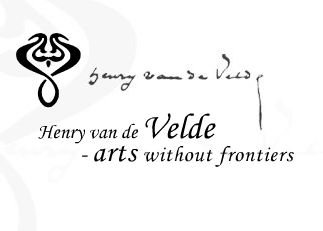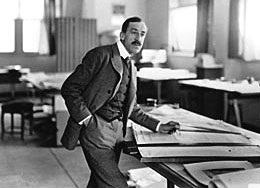The presentation of the book 'Henry van de Velde in Polen' at the 'Henry van de Velde - Arts without Frontiers' international conference held in Trzebiechów on September 28, 2007.
Ladies and Gentlemen,
History, especially the common history of Germany and Germans and their neighbours, the common cultural traditions and the common European cultural heritage are but a few areas of interest for the German Forum for the Culture of Central and Eastern Europe, which I have the honour of representing.
At today's conference we would like to present to you a very special - once forgotten, then rediscovered - fragment of our common European culture and history. I consider it a great honour and privilege to be able to present our new book 'Henry van de Velde in Polen. Innerarchitektur im Sanatorium Trebschen' ['Henry van de Velde. The Interior Architecture of the Sanatorium in Trzebiechów/Trebschen'].
Indeed, it is a rare occasion to be able to supplement a catalogue of works of art by an eminent (or 'classical' - as art historians recognize him) artist. This is what happened here in Trzebiechów, where in the year of 2002 a forgotten work of art by Henry van de Velde, a Belgian artist and architect of Secession, was rediscovered. It was here in Trzebiechów, formerly known as Trebschen, in the sanatorium erected in the years 1903 - 1905 that van de Velde realized one of his significant works of art: the architecture of the sanatorium buildings and the interior furnishings therein. In 2002 the discovery was a great sensation and has been one ever since.
A while ago, Mrs Leonie Beiersdorf, a connoisseur of Henry van de Velde and his artistic output, presented to us the artist himself and his work. Without him, there would not be today's conference and there wouldn't be our book. Without him, Trzebiechów and the Zielona Góra county would be deprived of one significant attraction.
Van de Velde was an artistic genius of European - and not only - calibre. He was one of the initiators of 'Art Nouveau'. In 1902 he moved to Weimar. It was there that he realized his first commissions: the Esche villa in Chemnitz, designed as a homogenous work of art, the reconstruction of the ground floor in the Nietsche Archive in Weimar and the furnishing of the interiors of the sanatorium in Trzebiechów (1903 - 1904).
Among those, the sanatorium in Trzebiechów served a special role. Since its opening in 1905, for over a hundred years it remained unknown to experts and scientists as well as to the general public. Van de Velde did not mention the design either in his biography or in the catalogue of his works. In consequence, no reference to the complex has been made in professional literature over the last 50 years.
With the discovery - after 100 hundred years of oblivion - of one of the most important works by Henry van de Velde - as it is now treated in Europe - the little Trzebiechów has become a place of interest for the world of culture and art. The interior furnishings of the former Trzebiechów sanatorium, which were made in the years 1903 - 1905, have been systematically restored, thus revealing even more artistic details than initially expected.
That is how the painting decorations, made in the patterned stencil technique, saw the light of day. Well - hidden under numerous layers of overpainting, it is the richest and best - preserved work by Henry van de Velde in Europe.
The German Forum for the Culture of Central and Eastern Europe has recently published a bilingual Polish-German album on the subject, entitled 'Henry van de Velde in Poland. The Interior Architecture of the Sanatorium in Trzebiechów/Trebschen'. Previous presentations of the book in various German cities reflect and confirm abiding interest in the work of Henry van de Velde, whose 50 th anniversary of death will be commemorated on October 25 th of this year.
Today is the Polish premiere; it is the first time that the book has been presented in Poland. This presentation is untypical. Most of today's speakers are connected both with the book, as co - authors or editors, and with the complex in Trzebiechów. We are in the very place - Trzebiechów. The interiors of the former sanatorium can be seen and experienced in situ. As I already mentioned, large-scale conservation work is being carried out here. Let me emphasise the fact that this is the only original work of art by Henry van de Velde to be found in Poland.
Our book is the first and only publication on the subject of this brilliant work and therefore provides a supplement to the catalogue of the artist's works, which - until quite recently - was considered complete and fully revised.
On behalf of the German Forum for the Culture of Central and Eastern Europe I would like to express my warmest thanks to Mr Edwin Łazicki, the Zielona Góra County Governor, Mr Stanisław Szeląg, the Trzebiechów Commune Governor, and above all to Mrs Agnieszka Szeląg, the director of the Nursing Home in Trzebiechów, for the invitation and their hospitality. I would also like to wish you, Ladies and Gentlemen, a beautiful, interesting day and hope that our book makes for compelling reading.
Thank you for your attention.



